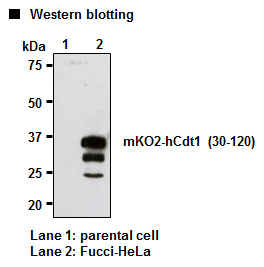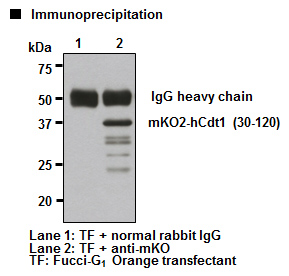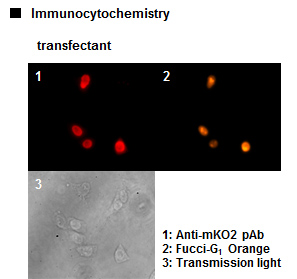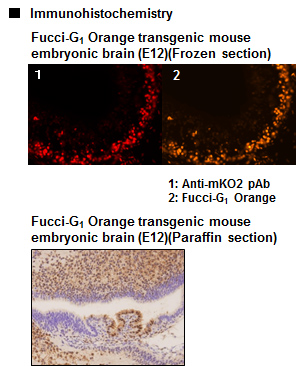Antibody detailed product information
| Code No. | PM051M | |
| Anti-monomeric Kusabira-Orange 2 pAb | ||
| Size | 100 µL | |
| Availability (in Japan) | 10 or more
(In Japan at 00:05, Apr 20, 2024 in JST) |
|
| Clonality | Polyclonal | |
| Clone | Polyclonal | |
| Isotype (Immunized Animal) |
Rabbit IgG (aff.) | |
| Applications | WB 1:1,000 IP 2 µL/Sample IC 1:500 (PMID: 25273397 / 28129541) IH 1:500 (Heat treatment is necessary.) |
|
| Immunogen (Antigen) |
Recombinant mKO2 | |
| Storage buffer | PBS/50% glycerol, pH 7.2 | |
| Storage temp. | -20°C | |
| Conjugate | Unlabeled | |
| Manufacturer | MBL | |
| Background | CoralHue™ Kusabira-Orange (KO) has been cloned from the stony coral, whose Japanese name is “Kusabira-ishi”. Wild-type CoralHue™ KO forms a brightly fluorescent dimer. CoralHue™ KO has been carefully engineered to form a monomer, CoralHue™ monomeric Kusabira Orange 1 (mKO1) that maintains the brilliance and pH stability of the parent protein. CoralHue™ mKO2 is the mutant of mKO1 and has a feature of the rapid maturation. It absorbs light maximally at 551 nm and emits orange light at 565 nm. CoralHue™ mKO2 can be used to label proteins or subcellular structures, or for reporter assay. | |
| Related products | M168-3M Anti-monomeric Kusabira-Orange 2 mAb AM-V9001M pFucci-G1 Orange (Cloning vector) AM-V9003M pFucci-G1 Orange (Expression vector) AM-V0141M CoralHue® monomeric Kusabira-Orange 2 (pmKO2-S1) AM-V0145M CoralHue® humanized monomeric Kusabira-Orange 2 (phmKO2-MC1) |
|
| Product category | Tools:Fluorescent proteins | |
| Data |     |
|
| Citations | Immunocytochemistry
Immunohistochemistry
|
|
- The availability is based on the information in Japan at 00:05, Apr 20, 2024 in JST.
- The special price is shown in red color.
- Please note that products cannot be ordered from this website. To purchase the items listed in this website, please contact us or local distributers.
- Abbreviations for applications:
WB: Western Blotting, IH: Immunohistochemistry, IC: Immunocytochemistry, IP: Immunoprecipitation
FCM: Flow Cytometry, NT: Neutralization, IF: Immunofluorescence, RIP: RNP Immunoprecipitation
ChIP: Chromatin Immunoprecipitation, CoIP: Co-Immunoprecipitation
DB: Dot Blotting, NB: Northern Blotting, RNA FISH: RNA Fluorescence in situ hybridization - For applications and reactivity:
*: The use is reported in a research article (Not tested by MBL). Please check the data sheet for detailed information.
**: The use is reported from the licenser (Under evaluation or not tested by MBL).
- For storage temparature: RT: room temparature
- Please note that products in this website might be changed or discontinued without notification in advance for quality improvement.
 Copyright (C)2015 Medical & Biological Laboratories Co., Ltd. All Rights Reserve
Copyright (C)2015 Medical & Biological Laboratories Co., Ltd. All Rights Reserve